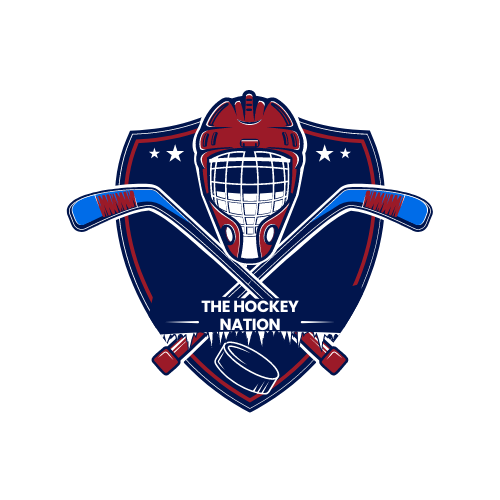I was recently contemplating purchasing a new hockey helmet, and it sparked an intriguing idea. Why not develop a comprehensive buying guide that assists individuals in selecting the optimal hockey helmet to suit their needs?
Hockey helmets are crucial safety gear for players, with properly fitted and certified helmets significantly reducing the risk of head injuries, including concussions. This not only enhances safety but also boosts players’ confidence to perform at their peak level.
The significance of hockey helmets lies in shielding players from head injuries, ranging from minor cuts and bruises to more severe trauma.
Engineered to absorb and distribute impact forces, these helmets play a vital role in minimizing potential head and brain damage. With continuous advancements in helmet technology, manufacturers are dedicated to enhancing comfort and safety features in their products.

In order to provide valuable insights on selecting the right hockey helmet, I have crafted a detailed guide. This guide covers a wide array of topics, including safety standards, helmet variations, essential features to consider, fitting guidelines, prominent brands, purchasing avenues, and maintenance tips.
By delving into this guide, you will acquire a comprehensive understanding of how to make an educated choice when investing in a hockey helmet to ensure your safety and comfort on the ice. To offer a glimpse of what to expect, let’s briefly outline the key takeaways awaiting you in this informative guide:
Understanding Hockey Helmet Safety Standards
A. Certification organizations
When choosing a hockey helmet, it’s crucial to grasp the safety standards established by different certification organizations. These bodies guarantee that helmets adhere to rigorous criteria for both protection and performance.
The three primary certification organizations include the CSA (Canadian Standards Association), HECC (Hockey Equipment Certification Council), and CE (European Conformity).
Ensuring that your helmet carries the appropriate certification from these reputable organizations can provide you with the confidence that you’re investing in top-notch headgear for your safety on the ice.
- CSA (Canadian Standards Association)
- HECC (Hockey Equipment Certification Council)
- CE (European Conformity)
CSA (Canadian Standards Association): The CSA is like the guardian angel for Canadian products, making sure they’re top-notch in performance and safety. When it comes to hockey helmets, CSA certification means they’ve got your back with impact protection, material strength, and durability.
HECC (Hockey Equipment Certification Council): Think of the HECC as your trusty sidekick in the US, certifying all things hockey gear, including helmets. Helmets with HECC certification have been through the wringer in testing to meet the safety standards of the game.
CE (European Conformity): The CE mark is like the stamp of approval in Europe, showing that a product is up to snuff in safety and performance. Hockey helmets with CE certification are game-ready for European leagues and tournaments.
Learn the rules of ice hockey, including penalties, face-offs, offside, and icing calls, with our blog on Hockey101.
B. Certification stickers and labels
Certification stickers and labels play a crucial role in ensuring the safety of Ice hockey helmets. When shopping for hockey helmets, particularly in local stores or brands, it is vital to pay attention to these stickers and labels.
They serve as indicators that the helmet complies with specific safety standards established by various certification organizations.
By looking for these certification stickers or labels when making a purchase, you can have the confidence that the helmet has been thoroughly tested and meets all the necessary safety requirements, providing you with peace of mind while engaging in the sport.
C. Expiration dates and replacement recommendations
Since nothing can last forever, including hockey helmets, it’s important to understand that their protective capabilities can diminish over time.
Factors like wear and tear, impacts, and exposure to various environmental conditions can all contribute to this decline. For this reason, certification organizations have set expiration dates and replacement guidelines for helmets to guarantee that players are using gear that can still provide sufficient protection.
Most helmets come with an expiration date or a “valid through” date printed on the certification sticker or label, typically falling within a span of five to ten years from the manufacturing date.
It is critical to replace your helmet once it reaches its expiration date or displays signs of damage, such as cracks in the shell, compromised foam padding, or broken straps. Remember to routinely inspect your helmet and follow replacement recommendations to ensure your safety on the ice.
Types of Hockey Helmets
Ice hockey helmets come in various types, each designed to serve specific purposes and provide different levels of protection. Understanding the nuances of these helmet variations is crucial when selecting the right one for your needs.
The main types of hockey helmets include traditional helmets, full-face shields, hybrid helmets combining a visor and cage, and specialized helmets for goalie positions. Each type caters to distinct preferences and safety requirements, ensuring players can choose the best option according to their playing style and level of protection desired.
A. Traditional hockey helmets
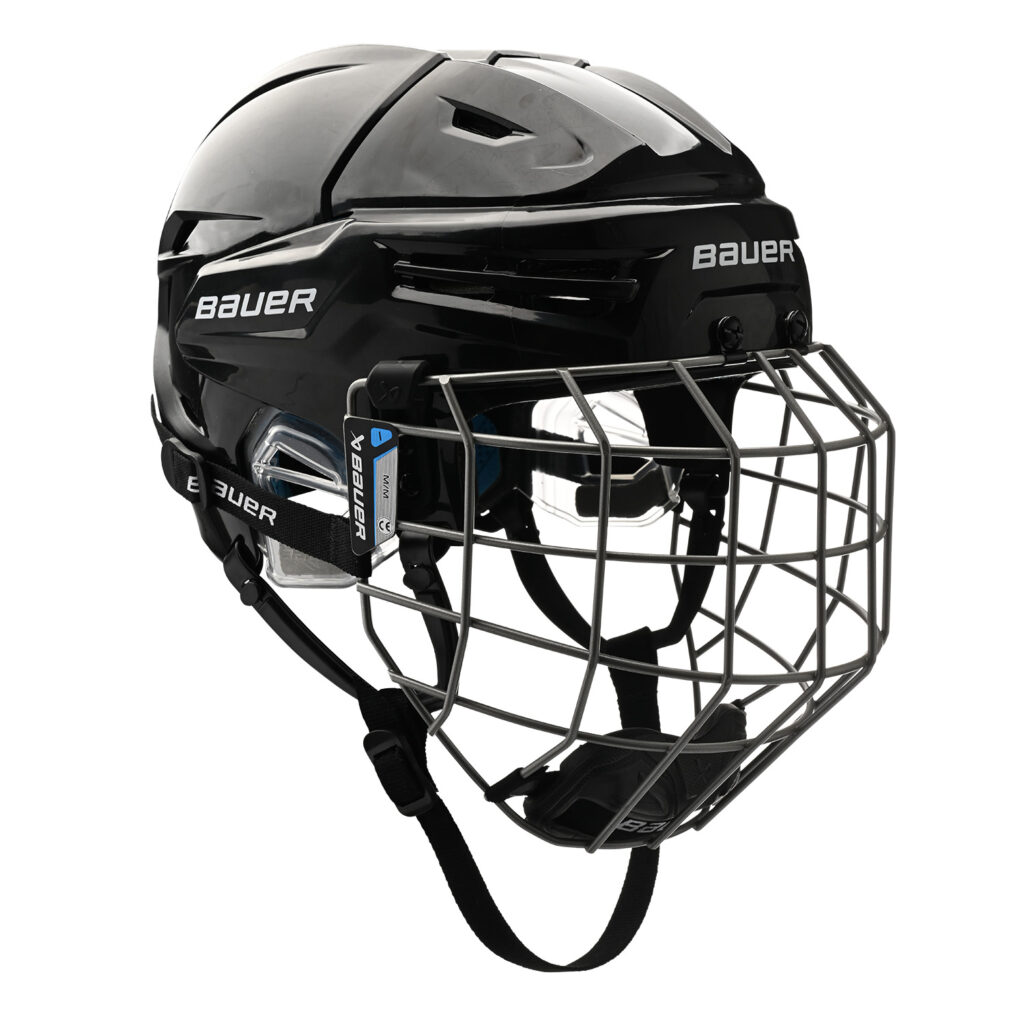
Traditional hockey helmets are meticulously crafted to cater to players of diverse skill levels and ages, ensuring a snug and secure fit.
Incorporating a durable hard plastic shell, soft foam padding, adjustable straps for personalized comfort, and strategically placed ventilation holes for optimal air circulation, these helmets prioritize both safety and performance on the ice.
Their versatile design allows for easy customization, making them a favored choice among hockey enthusiasts. It’s important to note that while traditional helmets provide excellent head protection, they do not include built-in face protection, necessitating the purchase of a separate face cage or shield for additional safety measures.
B. Combo helmets (with attached face cage or shield)
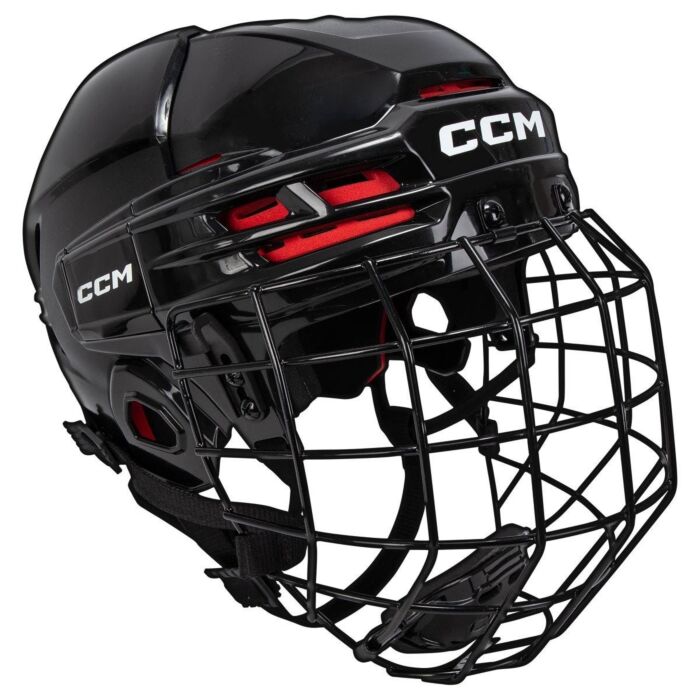
Combo helmets, a popular choice in sports gear, incorporate a face cage or shield for enhanced player safety. The face protection options include a full cage, which covers the entire face, or a half-shield, protecting just the eyes and nose. These helmets are designed to provide comprehensive head and face protection in a single, convenient piece of equipment. Players who value streamlined safety solutions often opt for combo helmets due to their integrated design and reliable performance on the field.
C. Goalie helmets

Goalie helmets or masks are meticulously engineered to meet the distinct demands and dangers encountered by goaltenders. Crafted with precision, these specialized helmets boast a full-face cage, strategically placed extra padding, and a reinforced shell to shield against powerful shots and potential collisions on the ice. The design also incorporates a unique shape that not only enhances peripheral vision but is tailored to seamlessly accommodate a goaltender’s mask for optimal comfort and protection. Undoubtedly, goalie helmets stand as indispensable gear, safeguarding goaltenders from the heightened risks associated with head and facial injuries in the fast-paced realm of ice hockey.
D. Youth helmets

Youth Hockey helmets are specially crafted for young players, usually aged 12 and under. These helmets, tailored for smaller heads, feature extra padding and adjustable elements to ensure a snug and comfortable fit as kids grow. They adhere to stringent safety standards designed for the specific needs of young athletes, prioritizing their well-being on the ice. When picking out a youth helmet, it’s crucial to choose one that is age-appropriate and certified by reputable safety bodies like the relevant organizations. This careful selection process ensures that young players are equipped with the right gear for optimal safety and performance.
In the detailed comparison table below, you’ll find a comprehensive overview of various types of hockey helmets, outlining their distinctive features and the level of protection they offer. This information empowers players to make well-informed choices when selecting the ideal helmet for their needs and preferences.
This table below provides a clear overview of different types of hockey helmets, their descriptions, and the level of protection they offer.
| Type of Helmet | Description | Level of Protection |
|---|---|---|
| Hybrid | Combination of traditional and full-face shield | High |
| Full-Face Shield | Full-face shield providing complete face coverage | High |
| Half-Shield | Half-face shield covering eyes and nose | Low to moderate |
| Traditional | Hard plastic shell covering top, sides, and back | Moderate to high |
| Goalie Mask | Specially designed for goaltenders | Maximum |
Key Features to Consider While Buying Hockey Helmets
When picking out a hockey helmet, make sure you’re on top of the game by checking out these key features that amp up safety, comfort, and performance. Here’s what you need to know:

A. Fit and sizing
Measuring head circumference: To get the perfect fit helmet, start by measuring your head circumference accurately. Take a flexible measuring tape and wrap it above your eyebrows around the widest part of your head, making sure it’s about 1 inch (2.5 cm) above your eyebrows. This measurement, based on the manufacturer’s sizing chart, will help determine whether you need a small, medium, or large helmet size.
Adjusting for the proper fit: Once you’ve identified the right size, it’s time to adjust the helmet for a snug and comfortable fit. Ensure the front edge of the helmet sits approximately 1 inch (2.5 cm) above your eyebrows, aligning it with your head. The helmet should fit securely without wobbling or sliding when you move your head. Remember, a well-adjusted helmet is crucial for both safety and comfort during your activities.
B. Construction materials
Polycarbonate shells: Polycarbonate, known for its lightweight and robust properties, is a favored material in premium hockey helmets. Its exceptional impact resistance makes it a top choice among competitive players who prioritize safety and performance on the ice.
ABS plastic shells: ABS plastic, a cost-effective alternative to polycarbonate, is commonly found in entry-level hockey helmets. While not as impact-resistant as polycarbonate, ABS plastic shells still offer commendable protection and durability, making them suitable for recreational players looking for reliable headgear.
Foam padding types: The interior padding of hockey helmets plays a crucial role in ensuring comfort and safety on the rink. Materials like expanded polypropylene (EPP), vinyl nitrile (VN), and multi-density foam are commonly used for their varying levels of impact absorption and cushioning. Trying on different helmet models can help you find the ideal padding material that suits your preferences for both protection and comfort.
C. Ventilation and comfort
Proper ventilation is paramount for maintaining comfort and minimizing sweat accumulation during physical activity. When selecting a helmet, it is important to opt for ones equipped with strategically positioned vents to facilitate airflow, thereby ensuring your head remains cool and dry throughout your play. Additionally, certain helmets may incorporate moisture-wicking liners, which serve to elevate comfort levels even further.
D. Face protection options
Full cage: If you’re after solid face protection, go for the full cage. It’s got your whole face covered with metal bars, great for younger players and those worried about dental or facial injuries.
Half shield: Opt for the half shield if you want better breathability and visibility. It’s a clear plastic visor that covers your eyes and nose but leaves your lower face open.
Hybrid shield: For the best of both worlds, try the hybrid shield. It’s a mix of a clear plastic visor for the upper face and a metal cage for the lower face, giving you a good balance of visibility and protection.
E. Chin strap and buckles
Chin straps and buckles play a crucial role in ensuring the helmet stays securely in place during play. When selecting a helmet, prioritize those with a comfortable, adjustable chin strap and durable buckles. The chin strap should be snug enough to prevent any movement of the helmet but should not cause discomfort or pressure points. This attention to detail in the helmet’s fit can enhance both safety and comfort during sports activities.
Check out below table, it provides a summary of key features to consider when buying hockey helmets, including their descriptions and importance.
The Hockey Nation
| Aspect | Description | Benefit |
|---|---|---|
| Liner Material | Multi-density foam that absorbs and disperses impact energy | Absorbs and reduces the force of impacts to the head |
| Certification | Helmets meeting safety standards set by organizations like HECC, CSA, and ASTM | Ensures the helmet has been tested and meets safety requirements |
| Fit | Helmets should fit snugly and comfortably, with no gaps | Proper fit ensures maximum protection and stability |
| Shell Material | Made of high-quality, durable materials such as polycarbonate or ABS plastic | Protects against hard impacts and reduces head injury risk |
| Cage/Visor | Provides clear vision while offering adequate protection | Protects the face and eyes from impact injuries |
| Ventilation | Good ventilation keeps the head cool and dry during play | Reduces heat buildup and increases comfort and focus |
This table format provides a concise overview of the key aspects to consider when choosing an ice hockey helmet.
The Cost of Hockey Helmets
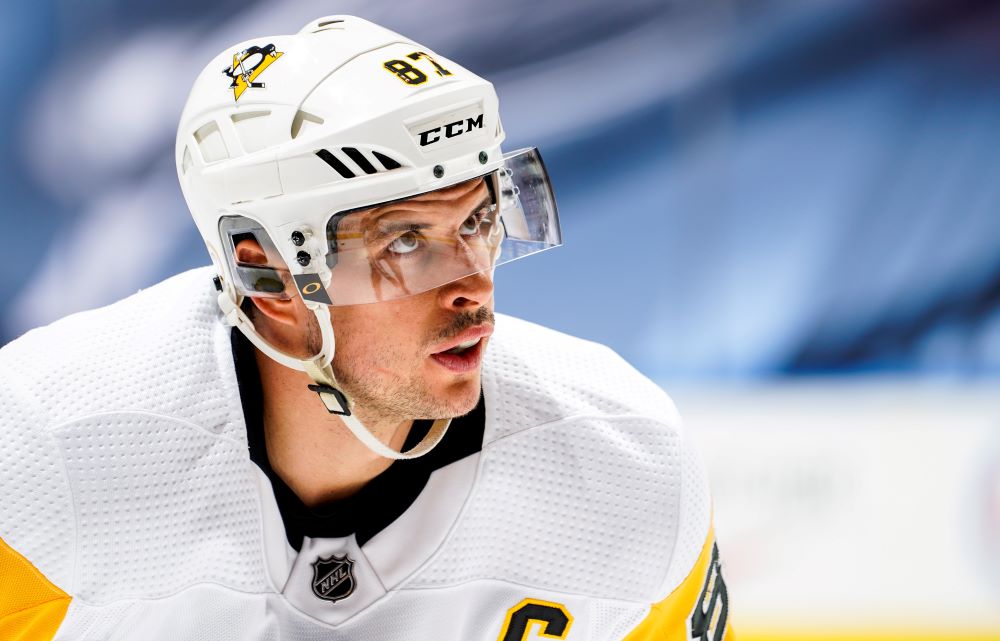
When on the hunt for a hockey helmet, make sure to score the perfect match of safety, quality, and affordability. Here are key factors to ace your choice:
A. Price range for different helmet types and features
The world of hockey helmets offers a range of options to suit every player’s needs. From affordable entry-level gear to top-of-the-line headgear with cutting-edge features, materials, and protection. Find your perfect match and stay safe on the ice!
| Type of Helmet | Average Cost Range | Factors that can Impact Cost |
|---|---|---|
| Traditional | $40 – $200 | Brand, additional features |
| Full-Face Shield | $100 – $350 | Brand, type of shield, additional features |
| Half-Shield | $50 – $200 | Brand, type of shield, additional features |
| Hybrid | $150 – $400 | Brand, type of shield, additional features |
| Goalie Mask | $200 – $1000 | Brand, type of cage, additional features |
This table format provides a clear overview of the different types of helmets, their average cost ranges, and the factors that can impact their costs.
B. Factors affecting the cost of a Ice hockey helmet
Numerous variables play a role in determining the pricing of a hockey helmet. These factors encompass the shell material type, foam padding quality, adjustability level, and presence of face protection.
Brand recognition and market demand further impact the pricing structure. Typically, helmets boasting superior materials, advanced features, reputable brands, and certifications command a higher price compared to their more fundamental counterparts.
C. Balancing safety, quality, and budget
I understand the importance of taking your budget into account when purchasing a helmet. However, it is absolutely vital not to overlook the aspects of safety and quality. When selecting a helmet, ensure it meets the necessary safety certifications, fits correctly, and provides suitable protection for your specific level of activity.
It is crucial to bear in mind that investing in a high-quality helmet can not only shield you from potential head injuries but also assist in reducing future medical costs associated with such incidents.
By prioritizing safety and quality in your helmet choice, you are not only safeguarding yourself during physical activities but also making a wise investment in your long-term well-being.
D. Tips for finding good deals on hockey helmets
Shop smart during sales events: If you want to score great deals on hockey equipment, keep an eye out for discounts offered by retailers at specific times of the year, such as the end of the season or holiday sales. By timing your purchases strategically, you can snag quality gear at wallet-friendly prices.
Explore online retailers: Opting for online stores can broaden your options and often lead to more competitive prices compared to traditional brick-and-mortar shops. Before making a purchase, delve into customer reviews to ensure product quality and scrutinize the return policy for added peace of mind.
Consider older models for savings: When new helmet models hit the shelves, previous versions may go on sale.
While these older models still provide robust protection, they come at a more budget-friendly cost. Embracing last year’s models can be a savvy move to save some cash without compromising on safety.
Dive into the world of used equipment: Browse through second-hand stores, online marketplaces, or local equipment swaps to find gently used helmets at a fraction of the original price.
Exercise caution when purchasing pre-owned helmets, as they could harbor hidden damage or be nearing their expiration date. Always verify the certification sticker and thoroughly inspect the helmet before finalizing your purchase.
Preparing to hit the ice? Discover our comprehensive beginner’s guide to ice hockey equipment, covering everything from skates and sticks to pads and helmets. Equip yourself with the knowledge you need to stay safe and fully geared up for your ice hockey adventures!
Trying On and Fitting a Hockey Helmet
Wearing a helmet that doesn’t fit right can be a real pain. When you’re picking out a hockey helmet, make sure to try on a few different styles and sizes to find the perfect fit. If you’re shopping online, check out the brand’s size chart and choose your size accordingly. Here are some tips for trying on and finding the right hockey helmet:
A. Importance of trying on helmets
Everyone’s head shape and size are different, so not all helmet styles will fit the same. Try on a few to find the most comfy and secure one. A properly fitted helmet gives better protection and reduces the risk of injury while you’re out there playing.
B. Steps to ensure a proper fit
Hey there! Here’s how to pick the right helmet:
- Measure your head size first using the manufacturer’s chart.
- When trying on the helmet, make sure it sits just above your eyebrows and feels level.
- Adjust the straps and padding for a comfy fit. It shouldn’t move around.
- Check for pressure points while wearing it. The padding should feel snug and comfy all around.
C. Adjusting the helmet and face protection
If your helmet has face protection, make sure it’s adjusted right. The cage or shield should be close but not on your nose or chin. The chin cup should snugly fit under your chin, and the straps should be tightened to keep everything in place.
D. Tips for comfort and optimal protection
Try out a few helmet models: Each one might have its own cool features or padding that fits your head shape just right.
Style your hair as you would during a game: If you usually wear a ponytail or a certain hairstyle when playing, try on helmets with your hair done the same way to make sure it fits well.
Get advice from a helpful sales associate: If you’re not sure about the fit or have questions, a sales associate or gear expert can guide you through the fitting process.
Check the fit again before buying: Wear the helmet for a bit before making your decision to make sure it’s comfy and secure. If anything feels off, adjust the helmet or try a different one.
Top Ice Hockey Helmet Brands
If you are familiar with the top brands in the hockey industry, it will greatly assist you when choosing a hockey helmet. Understanding the offerings of each brand, including their diverse features, materials, and price ranges, can lead to a more informed decision. Below, you will find details on some of the most reputable and well-known hockey helmet brands that cater to different preferences and needs.
A. Bauer
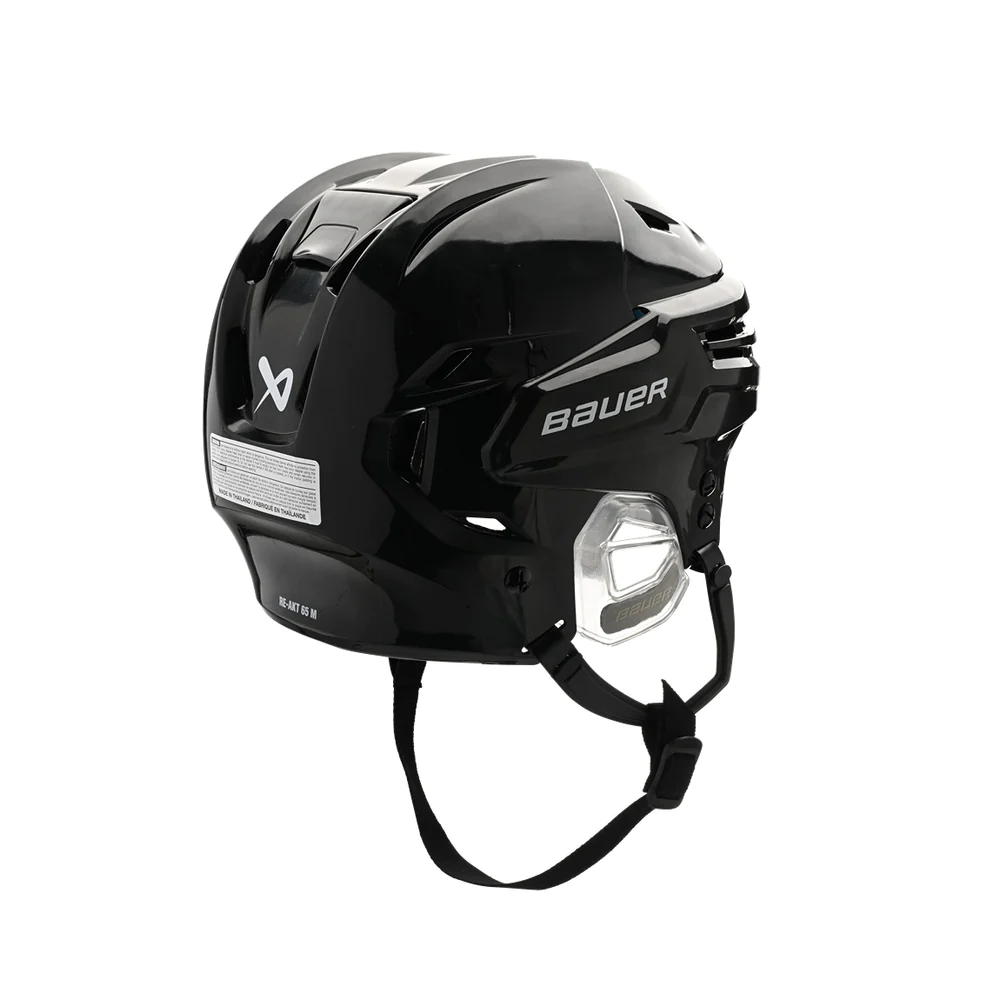
Bauer is a major player in the hockey equipment scene, offering a range of helmets to suit players of any skill level. Their helmets stand out for their cool designs, top-notch materials, and great protection. Check out their popular lines like RE-AKT, IMS, and Prodigy!
B. CCM
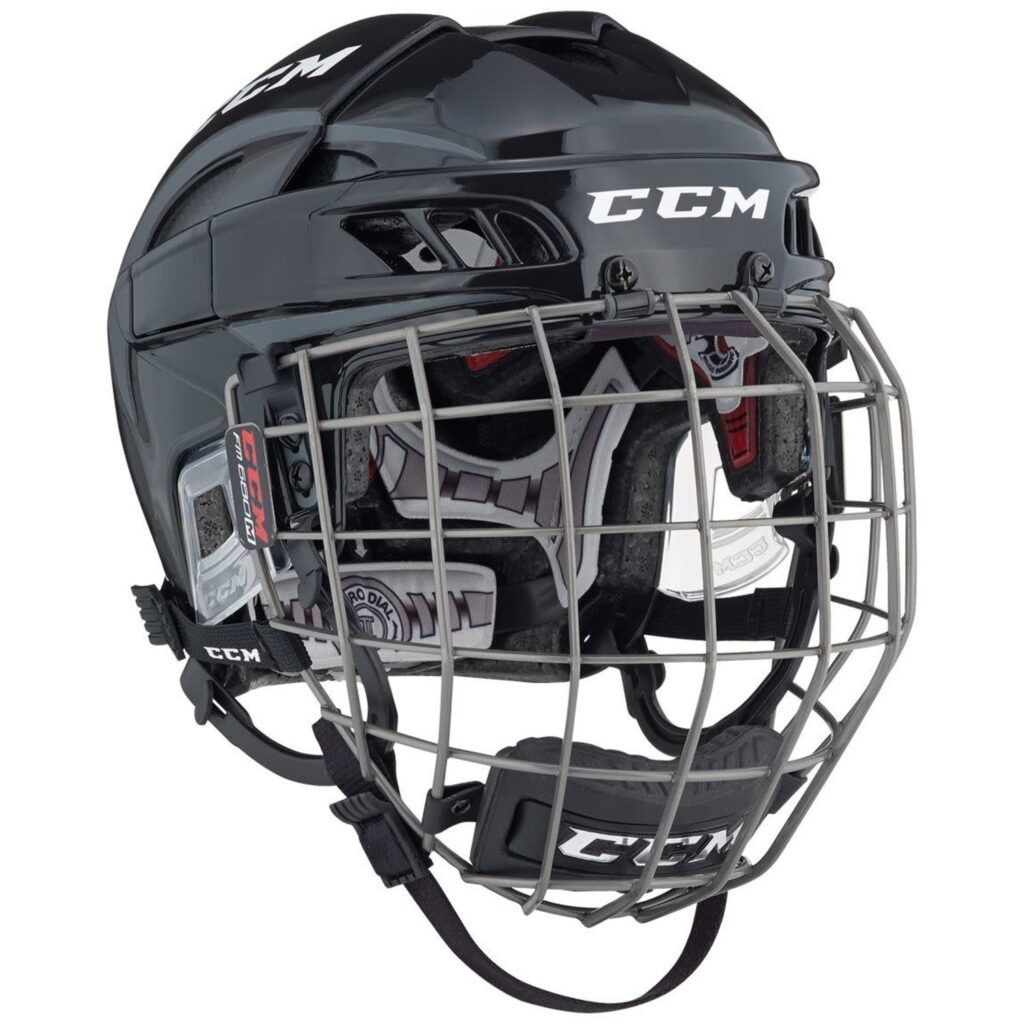
With a rich legacy of crafting top-tier gear, CCM stands as a prominent figure in the hockey equipment sector. Renowned for their commitment to excellence, CCM’s helmets are meticulously engineered to offer unrivaled comfort, superior protection, and peak performance on the ice.
Among CCM’s sought-after helmet lines are the Tacks, FitLite, and Resistance series, each designed with precision to cater to the diverse needs of hockey players at every level.
C. Warrior
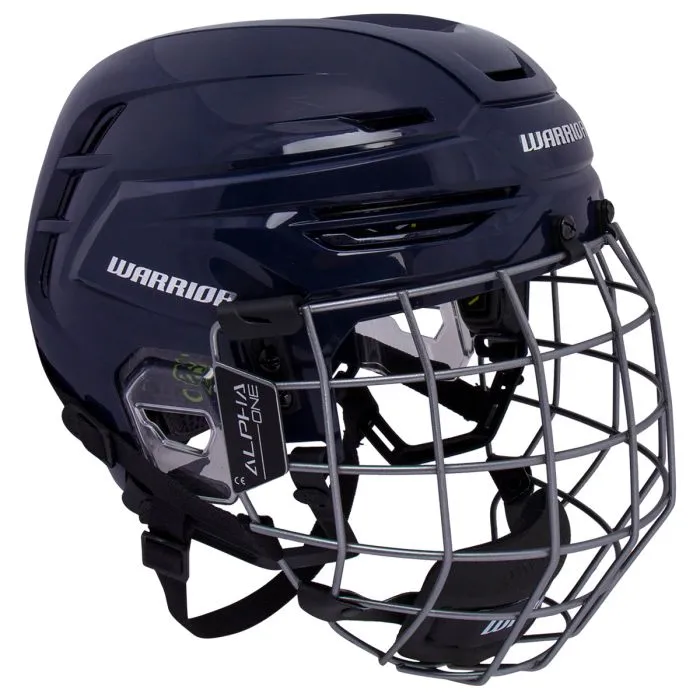
Warrior is widely recognized as a leading brand in the hockey industry, offering a diverse range of helmets equipped with state-of-the-art technology and advanced protective elements.
The innovative Warrior helmets, including the renowned Alpha and Covert series, are meticulously crafted to prioritize not only maximum comfort and adjustability but also exceptional impact absorption, ensuring players can focus on their performance with peace of mind.
D. True
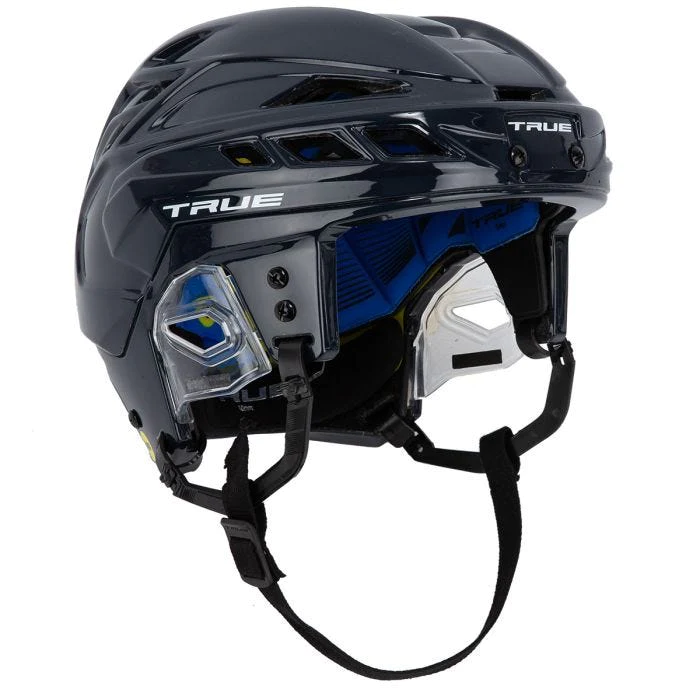
True is a relatively new player in the hockey equipment industry, but it has swiftly garnered acclaim for its commitment to crafting top-notch gear.
Their helmets stand out with cutting-edge designs and materials that prioritize not only safety but also comfort and personalized fit.
The True Dynamic helmet line, in particular, has become a go-to option for players who value a blend of lightweight construction and customizable features, making it a favorite among athletes striving for peak performance on the ice.
E. STX
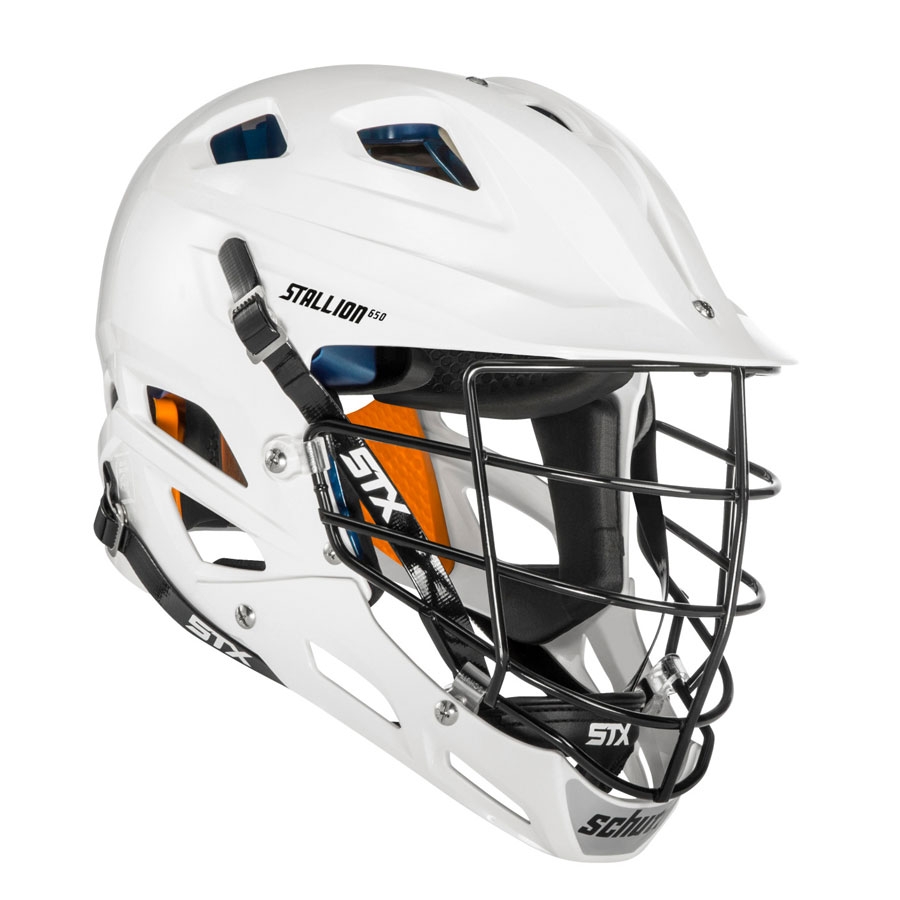
STX is renowned as a top-tier brand in the lacrosse equipment market, revered for its innovation and quality. Leveraging its success, STX has ventured into the realm of producing premium hockey gear, drawing upon its expertise to deliver high-performance equipment.
Notably, the meticulous design and exceptional quality synonymous with STX lacrosse products are also reflected in their hockey helmets, ensuring top-notch protection and comfort for players on the ice.
Among the array of options available, the STX Stallion and Surgeon helmet series stand out as popular choices among discerning hockey athletes, further solidifying STX’s position as a trusted name in sports gear.
F. Reebok
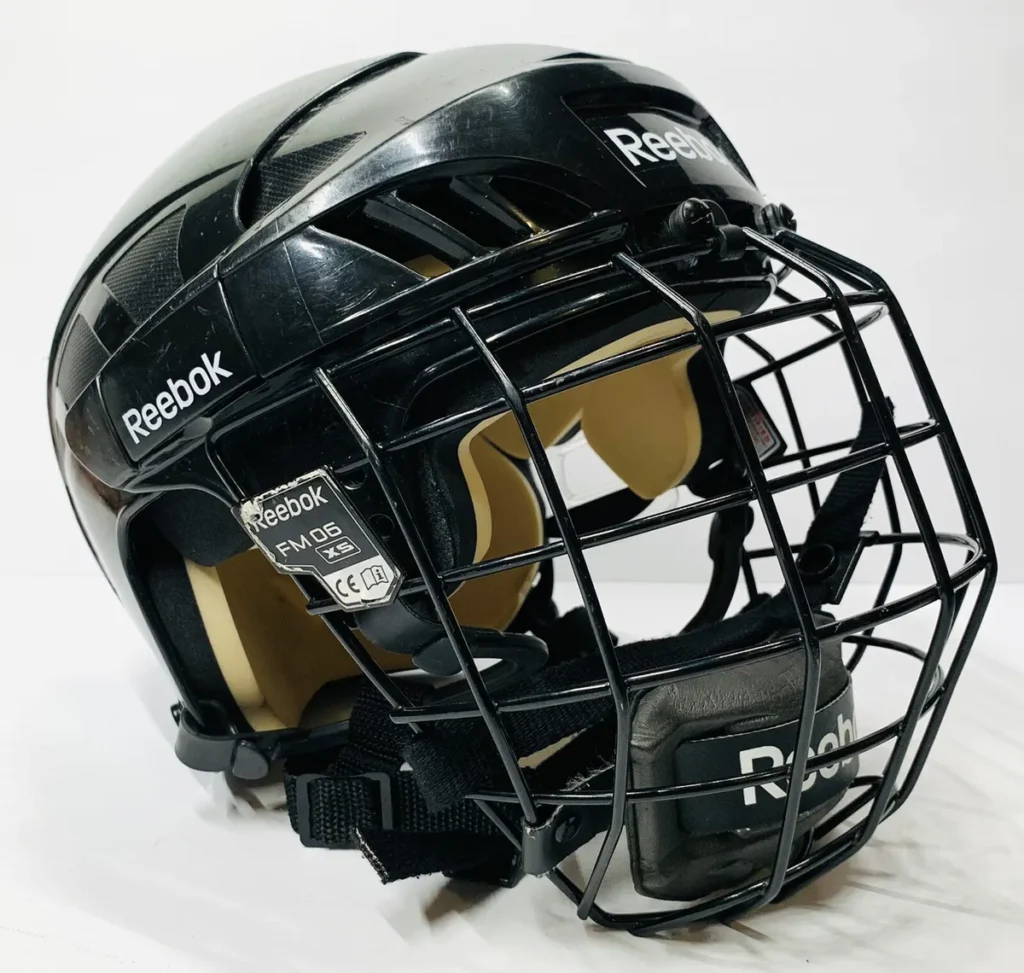
Although Reebok has transitioned its hockey equipment division to CCM, its legacy helmets can still be found on the market. The Reebok helmets, including the popular 11K and 7K models, continue to be sought after by players of all levels.
Known for their exceptional blend of protection and comfort, these helmets have become a staple choice for hockey enthusiasts looking for reliable gear to enhance their performance on the ice.
G. Vaughn

Vaughn is widely recognized as a top-tier brand in the realm of goaltending equipment. Their lineup features a range of high-quality goalie helmets meticulously crafted for superior protection and long-lasting durability.
Specifically, their renowned Ventus and Velocity series helmets are not only designed to meet the rigorous demands of the goaltending position but also excel in delivering exceptional impact resistance to safeguard goalies during intense gameplay.
Overview of Popular Hockey Helmet Brands and Helmets
This below table provides a clear overview of different hockey helmet brands, their descriptions, and popular helmet models associated with each brand.
| Brand | Description | Popular Helmets |
|---|---|---|
| Bauer | One of the most popular brands of hockey helmets | Bauer Re-Akt, Bauer 960 |
| CCM | Offers a range of helmets for different skill levels | CCM Resistance, CCM Fitlite 3DS, CCM Tacks |
| Warrior | Known for innovative designs and customization | Warrior Alpha One, Warrior Covert QR Edge, Warrior PX2 |
| Easton | Offers lightweight and comfortable helmets | Easton Stealth RS, Easton E700 |
| True | Focuses on providing maximum protection and comfort | True Dynamic 9, True TF9, True AX9 |
| Sherwood | Provides a range of helmets at affordable prices | Sherwood 5030, Sherwood T90 |
| Reebok | Offers helmets with adjustable sizing and ventilation | Reebok 11K, Reebok 7K |
| Vaughn | Specializes in goalie helmets for maximum protection | Vaughn Velocity V7 XF Pro Carbon, Vaughn Ventus SLR Pro Carbon |
| STX | Known for their lacrosse equipment, also offers hockey helmets | STX Surgeon RX3, STX Stallion HPR 1.2 |
Where to Buy Hockey Helmets

Discovering the perfect hockey helmet is a journey filled with options, each offering unique advantages and constraints. Here’s a guide to navigate your quest for the ideal headgear:
A. Local sporting goods stores
Many local sporting goods stores carry a diverse selection of hockey equipment, from skates to sticks, and of course, helmets.
When you shop at a nearby store, you can take your time trying on various helmet models and sizes, ensuring you find the perfect fit for both safety and comfort on the ice.
Moreover, the knowledgeable sales associates are on hand to offer expert advice and guidance, helping you choose the ideal helmet that meets your specific requirements and preferences.
B. Hockey specialty shops
Hockey specialty stores really know their stuff when it comes to gear, especially helmets. The staff there are super knowledgeable and can give you great advice on picking the perfect helmet for you. Plus, you might even find some cool exclusive models or limited-edition gear while you’re there!
C. Online retailers
Hey there! Online retailers offer the convenience of shopping from home and usually have a wider range of helmets than traditional stores. Plus, you can often find better prices online. When you shop online, remember to read reviews, look into the return policy, and make sure the helmet meets safety standards. Since you can’t try it on before buying, measure your head accurately and check the manufacturer’s sizing chart. Happy shopping!
D. Secondhand and used equipment stores
If you are new to the sport or working within a budget, opting for a pre-owned helmet can provide a cost-effective solution.
Consider exploring Second Hand stores, online platforms, or local gear exchanges for gently used helmets that are available at a fraction of the original price.
Nevertheless, exercise caution when purchasing second-hand helmets, as they might possess hidden damage or be nearing their expiration date. Always verify the certification sticker and conduct a thorough inspection of the helmet before finalizing your purchase.
As you venture into the process of selecting the perfect hockey helmet, it’s crucial to delve into the vast realm of hockey equipment.
Dive into renowned Hockey Helmet Brands to unearth high-quality options, explore leading Hockey Skate Brands for top-notch skates, and discover the ideal Hockey Stick Brands for your gameplay.
Furthermore, for an in-depth analysis comparing CCM and Bauer, explore our detailed review of CCM vs. Bauer. To gain insights into various hockey clothing brands, check out Hockey Clothing Brands for a comprehensive guide. Equipping yourself with the right gear is the first step towards achieving excellence on the ice.
Tips for Maintaining Your Hockey Helmet

Caring for your hockey helmet is crucial to keep it protective and lasting longer. Check out these handy tips to maintain your hockey helmet:
A. Regular inspection for damage
Frequent inspection of your helmet is crucial for safety. Look out for indicators like cracks in the shell, dents, or broken buckles.
Additionally, examine the foam padding for any signs of deterioration or compression. If you notice any damage or wear, it might be necessary to replace the helmet or specific components to ensure its effectiveness in protecting you. Your safety is paramount, so staying vigilant with helmet maintenance is key.
B. Cleaning and hygiene
Sweat and bacteria can accumulate in your helmet over time, resulting in unpleasant odors and the potential for skin irritation. To maintain a clean and fresh helmet, start by removing any removable padding and following the manufacturer’s washing instructions.
After washing the padding, proceed to wipe down the shell, cage, and non-removable components using a damp cloth and mild soap. Allow all parts to air dry thoroughly before reassembling the helmet.
Remember to steer clear of harsh chemicals or solvents, as they may cause damage to the materials and compromise the helmet’s integrity. By following these steps diligently, you can ensure your helmet stays hygienic and in top condition for your next adventure.
C. Storing your helmet properly
Store your hockey helmet in a cool, dry place away from direct sunlight and excessive heat. It’s important to protect it from the elements to maintain its integrity.
This will significantly reduce the risk of the materials deteriorating over time, ensuring your helmet remains in top condition for longer.
Additionally, avoid placing heavy objects on top of the helmet, as this can lead to the shell warping or cracking, compromising the helmet’s effectiveness in providing protection. Remember, proper storage and care can extend the lifespan of your helmet and keep you safe on the ice.
D. Knowing when to replace your helmet
Hockey helmets, crucial for player safety, have a limited lifespan. Their protective abilities diminish with time due to repeated impacts and material wear.
To maintain optimal safety, most manufacturers advise replacing your helmet every 5 to 7 years. If your helmet endures substantial damage, don’t hesitate to replace it sooner.
Remember to inspect the certification sticker for an expiration date, as safety certifications are only valid for a specific period. Prioritize your safety on the ice by promptly replacing your helmet when needed.
Common Questions on Buying Hockey Helmets
What makes a good hockey helmet?
In my opinion, a solid hockey helmet needs to offer top-notch protection, feel comfy, fit just right, and meet all the safety requirements.
Where do you find the size of a hockey helmet?
Hockey helmet sizes are typically on a sticker inside the helmet or its packaging. You can also check the manufacturer’s website for this info.
What size hockey helmet should I wear?
You can measure around your head above your eyebrows and then check the manufacturer’s size chart to find your fit.
How does a hockey helmet fit?
A hockey helmet needs to fit snugly and evenly around your head, with no pressure points or gaps. Make sure it sits level on your head, covering your temples and forehead.
How do I choose a hockey helmet for my child?
When picking out a hockey helmet for a kid, go for one that fits right, feels comfy, and meets safety standards. Also, think about the child’s skill level and any extras like a cage or full face shield.
What helmet is better Bauer or CCM?
Both Bauer and CCM offer top-notch hockey helmets. The right choice for you comes down to what you like and what you need.
What helmet do most NHL players use?
There isn’t a single helmet that most NHL players go for. Lots of players like Bauer and CCM helmets, but in the end, it’s all about personal choice.
Are expensive hockey helmets worth it?
Pricey hockey helmets usually have extra features and high-tech stuff for better protection and comfort. But remember, the key thing is making sure the helmet meets safety standards and fits right.
Should a hockey helmet fit tight or loose?
A hockey helmet needs to fit comfortably and evenly on your head, without any tight spots or gaps. Just make sure it’s not too loose or too tight.
What is the best brand of hockey helmet?
There are loads of top-notch hockey helmet brands like Bauer, CCM, Warrior, Easton, and others. Bauer and CCM are the fan favorites.
Conclusion
Investing in a high-quality hockey helmet is crucial for safeguarding yourself from potential head injuries during intense gameplay. By prioritizing safety with a meticulously fitted and certified helmet, you significantly decrease the likelihood of concussions and other head traumas, allowing you to focus on mastering your skills on the ice with peace of mind.
Choosing the perfect hockey helmet tailored to your specific needs not only enhances your safety but also boosts your confidence on the rink. Take the time to select a helmet that aligns with your requirements, ensuring maximum protection and comfort. Stay secure, play with confidence, and make the most of every moment on the ice!
